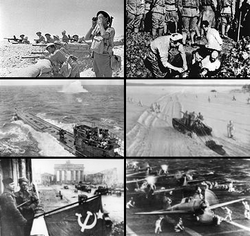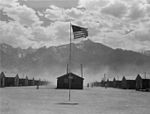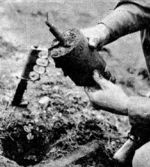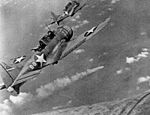- Portal:World War II
-
 American Civil War · American Revolutionary War · Battleships ·
American Civil War · American Revolutionary War · Battleships ·  Biological warfare · British Army · Canadian Forces · Cold War · Crusades ·
Biological warfare · British Army · Canadian Forces · Cold War · Crusades ·  Italian Wars · Military history of Africa · Military history of France · Military history of the Ottoman Empire · Military of ancient Rome ·
Italian Wars · Military history of Africa · Military history of France · Military history of the Ottoman Empire · Military of ancient Rome ·  Military of Australia · Military of Germany ·
Military of Australia · Military of Germany ·  Military of Greece · Military of Pakistan ·
Military of Greece · Military of Pakistan ·  Military of the United States ·
Military of the United States ·  Napoleonic Wars · NATO · Royal Air Force · Royal Navy · Submarine · Tank ·
Napoleonic Wars · NATO · Royal Air Force · Royal Navy · Submarine · Tank ·  Terrorism ·
Terrorism ·  United States Air Force · United States Army · United States Coast Guard · United States Marine Corps ·
United States Air Force · United States Army · United States Coast Guard · United States Marine Corps ·  United States Navy ·
United States Navy ·  War · War of 1812 · Weapons of mass destruction ·
War · War of 1812 · Weapons of mass destruction ·  World War I ·
World War I ·  World War II
World War II
The World War II Portal
World War II, or the Second World War, was a global military conflict. It began as the joining of what had initially been two separate conflicts, with the first beginning in Asia in 1937 (the Second Sino-Japanese War) and the other beginning in Europe in 1939 (the German invasion of Poland).
The war split the majority of the world's nations into two opposing military alliances: the Allies and the Axis. It involved the mobilization of over 100 million military personnel, making it the most widespread war in history, and placed the participants in a state of "total war", which erased the distinction between civil and military resources and resulted in the complete activation of a nation's economic, industrial, and scientific capabilities for the purposes of the war effort. Over 70 million people, the majority of them civilians, were killed, making it the deadliest conflict in human history.
The Allies won the war, and as a result, the Soviet Union and the United States emerged as the world's leading superpowers. This set the stage for the Cold War, which lasted for the next 45 years. The United Nations was formed in the hope of preventing another such conflict. The self determination spawned by the war accelerated decolonization movements in Asia and Africa, while Europe itself began moving toward integration.
Featured article
Manzanar is most widely known as the site of one of ten camps where over 110,000 Japanese Americans were imprisoned during World War II. Located at the foot of the Sierra Nevada in California's Owens Valley between the towns of Lone Pine to the south and Independence to the north, it is approximately 230 miles (370 km) northeast of Los Angeles. Manzanar (which means “apple orchard” in Spanish) was identified by the United States National Park Service as the best-preserved of the former camp sites, and was designated the Manzanar National Historic Site.Long before the first prisoners arrived in March 1942, Manzanar was home to Native Americans, who mostly lived in villages near several creeks in the area. Ranchers and miners formally established the town of Manzanar in 1910, but abandoned the town by 1929 after the City of Los Angeles purchased the water rights to virtually the entire area. As different as these groups might seem, they are tied together by the common thread of forced relocation. Since the last prisoners left in 1945, former prisoners and others have worked to protect Manzanar and to establish it as a National Historic Site that preserves and interprets the site for current and future generations.Selected equipment
The German S-mine (Schrapnellmine in German), also known as the Bouncing Betty, is the best-known version of a class of mines known as bounding mines. These mines launch into the air at about waist height and explode, propelling shrapnel horizontally at lethal speeds. The S-mine was an anti-personnel landmine developed by Germany in the 1930s and used extensively by German forces during World War II. It was designed to be used in open areas to attack unshielded infantry. Two versions were produced, designated by the year of their first production: the SMi-35 and SMi-44. There are only minor differences between the two models.The S-mine entered production in 1935 and served as a key part of the defensive strategy of the Third Reich. Until production ceased with the defeat of Germany in 1945, Germany produced over 1.93 million S-mines.These mines were responsible for inflicting heavy casualties and slowing, or even repelling, drives into German-held territory throughout the war. The design was lethal, successful and much imitated, and remains one of the definitive weapons of World War II.Selected battle
The Battle of Midway was a major naval battle in the Pacific Theater of World War II. It took place from June 4, 1942 to June 7, 1942, approximately one month after the Battle of the Coral Sea, five months after the Japanese capture of Wake Island, and exactly six months to the day after Japan's attack on Pearl Harbor.During the battle, the United States Navy defeated a Japanese attack against Midway Atoll, losing one aircraft carrier and one destroyer, while sinking four Japanese carriers and a heavy cruiser.The battle was a decisive victory for the Americans, and is widely regarded as the most important naval engagement of the Pacific Campaign of World War II.The Midway operation, like the attack on Pearl Harbor, was not part of a campaign for the conquest of the United States, but was aimed at its elimination as a strategic Pacific power, thereby giving Japan a free hand in establishing its Greater East Asia Co-Prosperity Sphere. It was also hoped another defeat would force the U.S. to negotiate an end to the Pacific War with conditions favorable for Japan.Selected picture
A real-life Rosie the Riveter working on the A-31 Vengeance bomber in Nashville, Tennessee.
Selected biography
Sir Michael Francis Addison Woodruff was an English surgeon and scientist principally remembered for his research into organ transplantation. Though born in London, Woodruff spent his youth in Australia, where he earned degrees in electrical engineering and medicine. Having completed his studies shortly after the outbreak of World War II, he joined the Australian Army Medical Corps, but was soon captured by Japanese forces and imprisoned in the Changi Prison Camp. While there, he devised an ingenious method of extracting nutrients from agricultural wastes to prevent malnutrition among his fellow POWs.At the conclusion of the war, Woodruff returned to England and began a long career as an academic surgeon, mixing clinical work and research. Woodruff principally studied transplant rejection and immunosuppression. His work in these areas of transplantation biology, led Woodruff to perform the first kidney transplant in the United Kingdom, on 30 October 1960.
Did you know...
- ... that the British Army changed its plans for operations in Greece during World War II on medical advice from Australian Brigadier Sir Neil Fairley?
- ...that the Old Admiralty House, a national monument in Singapore, was used by the British Armed Forces for strategic planning during World War II?
- ...that U-106, was one of Germany's most successful submarines, sinking 22 Allied ships in World War II?
Categories
Selected quote
"No enemy bomber can reach the Ruhr. If one reaches the Ruhr, my name is not Goering. You may call me Meyer." - — Hermann Göring, September, 1939
Topics
Things you can do
From the World War II task force of the Military history WikiProject:
- Attention needed
- ...to referencing and citation • ...to coverage and accuracy • ...to structure • ...to grammar • ...to supporting materials
- Popular pages
- Full list
- Cleanup needed
- Battle of Kiev (1943) • Raid on Drvar • Colditz Castle
- Requested articles
- A Force • Battle of Uhtua-Kiestinki • Battles of Repola-Rukajärvi • Battle of Porlammi • Battle of Siiranmäki • Battle of Tuulos • Battle of Łuck • Battle of Równe • Battle of Włodzimierz Wołyński • Battle of Lubartów • Battle of Kock (1944) • Battle of Miedniki • Battle of Rudniki Forest • Battle of Jodła • Battle of Ceber • Francis Blanchain •Prosper Desitter • Shinshou Draenger • Christer Lyst Hansen • Holocaust slave labor litigation • Ove Kampman • League for Combat Policy • Julien Meline • Operation Rayon • Operation Bigot • Operation Mittelmeer • Operation Richard • Operation Waterfall • Otto Program • Martin Poppel • Roehm's Avengers • Dorothy Tartiere • Poul Bruun • Raoul Boulanger • Serge Asher-Ravanel • Battle of West Ukraine (1941) • Battle of Xinfeng • Battle of Zunyi
- Expansion needed
- Battle of Bay of Viipuri • Battle of Brunei • Battle of Labuan • Demilitarisation; Martha Desrumeaux • Mochitsura Hashimoto • Operation Cascade • Operation Tan No. 2 • Burma Area Army • Battle of Courland • Battle of Voronezh (1943) • First Battle of Kharkov • Race to Berlin • Marie Fourcade • Victor Strydonck de Burkel • Donald Blakeslee • Operation Nordwind • Battle of Skerki Bank • Michael Sinclair (soldier) • Battle of Maastricht • Battle of The Afsluitdijk • Battle of Zeeland • Landing at Saidor
- Images needed
- Twelfth Army (United Kingdom) • 4th Airborne Division (United Kingdom) • 5th Airborne Division (United Kingdom) • XVI Corps (United Kingdom)
- Merging needed
- Add an article here!
- Citations needed
- Add an article here!
- Translation needed
- de:Josef Meisinger • nl:Type 5 Na-To
visit task force · edit this list
To transclude this list, use {{WPMILHIST Announcements/World War II}}Associated Wikimedia
- Wikipedia portals:
- Culture
- Geography
- Health
- History
- Mathematics
- Natural sciences
- People
- Philosophy
- Religion
- Society
- Technology
Categories:- History portals
- World War II
Wikimedia Foundation. 2010.






